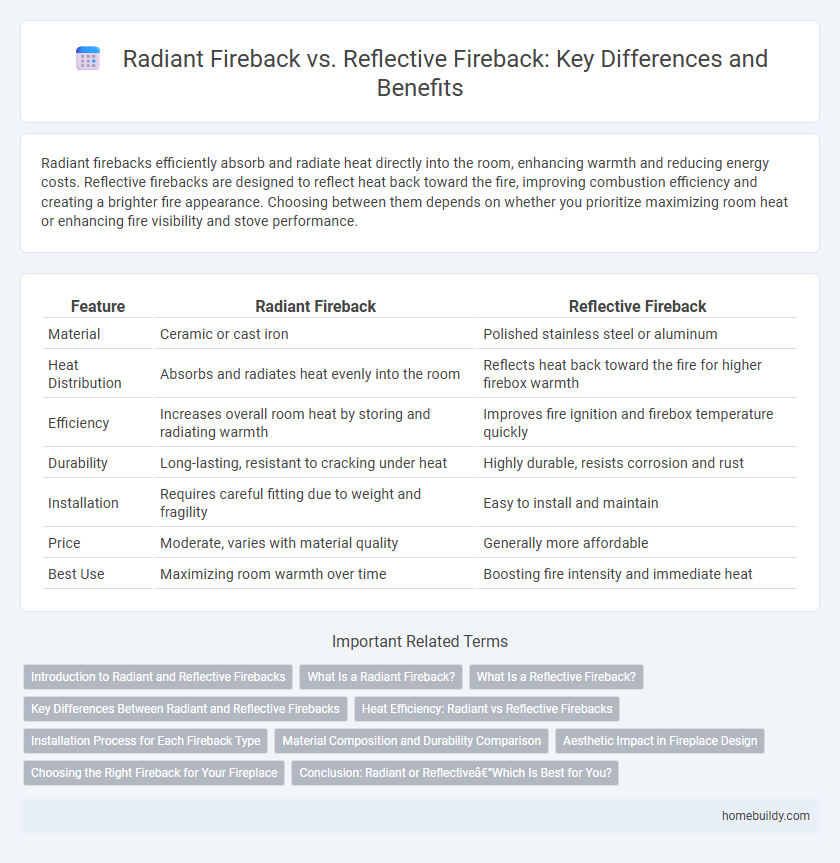Radiant firebacks efficiently absorb and radiate heat directly into the room, enhancing warmth and reducing energy costs. Reflective firebacks are designed to reflect heat back toward the fire, improving combustion efficiency and creating a brighter fire appearance. Choosing between them depends on whether you prioritize maximizing room heat or enhancing fire visibility and stove performance.
Table of Comparison
| Feature | Radiant Fireback | Reflective Fireback |
|---|---|---|
| Material | Ceramic or cast iron | Polished stainless steel or aluminum |
| Heat Distribution | Absorbs and radiates heat evenly into the room | Reflects heat back toward the fire for higher firebox warmth |
| Efficiency | Increases overall room heat by storing and radiating warmth | Improves fire ignition and firebox temperature quickly |
| Durability | Long-lasting, resistant to cracking under heat | Highly durable, resists corrosion and rust |
| Installation | Requires careful fitting due to weight and fragility | Easy to install and maintain |
| Price | Moderate, varies with material quality | Generally more affordable |
| Best Use | Maximizing room warmth over time | Boosting fire intensity and immediate heat |
Introduction to Radiant and Reflective Firebacks
Radiant firebacks are designed with a heavy, cast-iron surface that absorbs and radiates heat back into the room, enhancing fireplace efficiency by providing consistent warmth. Reflective firebacks feature a polished, smooth steel or stainless-steel surface that reflects radiant heat outward, maximizing heat distribution and visually brightening the fireplace. Both types improve heat output but differ in heat transfer methods and aesthetic appeal, making the choice dependent on heating needs and design preferences.
What Is a Radiant Fireback?
A radiant fireback is a heavy cast iron plate placed at the back of a fireplace to absorb and radiate heat into the room, enhancing warmth efficiency. Unlike reflective firebacks, which primarily bounce heat forward, radiant firebacks store thermal energy and release it gradually, providing consistent heat over time. This makes radiant firebacks ideal for maximizing heat retention and improving overall fireplace performance.
What Is a Reflective Fireback?
A reflective fireback is a metal plate installed at the back of a fireplace designed to reflect heat and light into the room, enhancing warmth and ambiance. Made from materials like cast iron or steel, it resists high temperatures while protecting the fireplace masonry from damage. Its reflective surface increases heat efficiency by directing radiant heat outward, unlike a radiant fireback that absorbs heat and slowly releases it.
Key Differences Between Radiant and Reflective Firebacks
Radiant firebacks are designed to absorb heat from the fire and gradually radiate it into the room, enhancing warmth efficiency by using thick cast iron that retains heat longer. Reflective firebacks, typically made of polished steel or mirrored surfaces, focus on reflecting radiant heat directly back into the firebox, increasing the fire's intensity and brightness. Key differences include material composition, heat distribution method, and the primary function of either heat retention and radiation (radiant) or heat reflection and fire enhancement (reflective).
Heat Efficiency: Radiant vs Reflective Firebacks
Radiant firebacks enhance heat efficiency by absorbing and then radiating warmth into the room, effectively increasing heat retention and distribution. Reflective firebacks improve heat output by reflecting infrared heat directly from the fireplace, boosting immediate warmth without absorbing heat. Choosing between radiant and reflective firebacks depends on whether sustained heat radiation or instant heat reflection is prioritized for your fireplace setup.
Installation Process for Each Fireback Type
Radiant firebacks require installation with high-temperature mortar to ensure secure adherence directly against the fireplace wall, optimizing heat radiation into the room. Reflective firebacks are typically installed using heat-resistant brackets or clips that create a small air gap between the fireback and the wall, enhancing reflective heat distribution. Proper installation of each fireback type is crucial for maximizing heat efficiency and preventing damage to the fireplace structure.
Material Composition and Durability Comparison
Radiant firebacks are typically constructed from cast iron, offering excellent heat retention and gradual radiance, which enhances energy efficiency and durability in long-term use. Reflective firebacks, made from polished stainless steel or aluminum, prioritize heat reflection into the room rather than absorption, providing quicker warmth but with less thermal mass and potential susceptibility to warping under high temperatures. Cast iron's robust composition ensures superior resistance to crack formation and deformation, while reflective metals require careful maintenance to retain their reflective properties and structural integrity over time.
Aesthetic Impact in Fireplace Design
Radiant firebacks enhance fireplace design by emitting warmth through a thick cast iron surface, creating a rustic, traditional aesthetic with a rich, textured appearance. Reflective firebacks feature polished steel or glass surfaces that bounce light and flames back into the room, offering a sleek, modern look that brightens the hearth area. Choosing between radiant and reflective firebacks significantly influences the visual ambiance and style, balancing warmth ambiance with contemporary shine.
Choosing the Right Fireback for Your Fireplace
Radiant firebacks are designed with heavy cast iron or steel to absorb and radiate heat directly into the room, making them ideal for maximizing warmth in stone or brick fireplaces. Reflective firebacks feature polished or stainless steel surfaces that bounce heat back from the fire, boosting efficiency especially in metal or less heat-retentive fireplace surrounds. Selecting the right fireback depends on your fireplace construction and heating goals, with radiant models best for heat storage and reflective types suited for directing warmth efficiently.
Conclusion: Radiant or Reflective—Which Is Best for You?
Radiant firebacks excel at maximizing heat output by absorbing and radiating warmth evenly into the room, ideal for those seeking efficient heating. Reflective firebacks, with their polished surfaces, enhance flame brightness and add a decorative element, perfect for users prioritizing aesthetic appeal. Choosing between radiant or reflective depends on whether your primary goal is optimal heat retention or enhancing the visual ambiance of your fireplace.
Radiant Fireback vs Reflective Fireback Infographic

 homebuildy.com
homebuildy.com